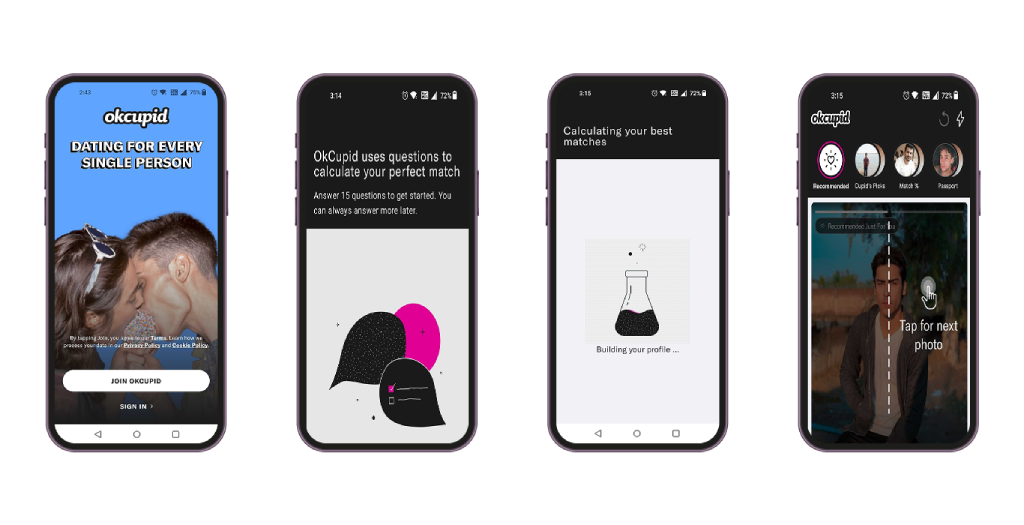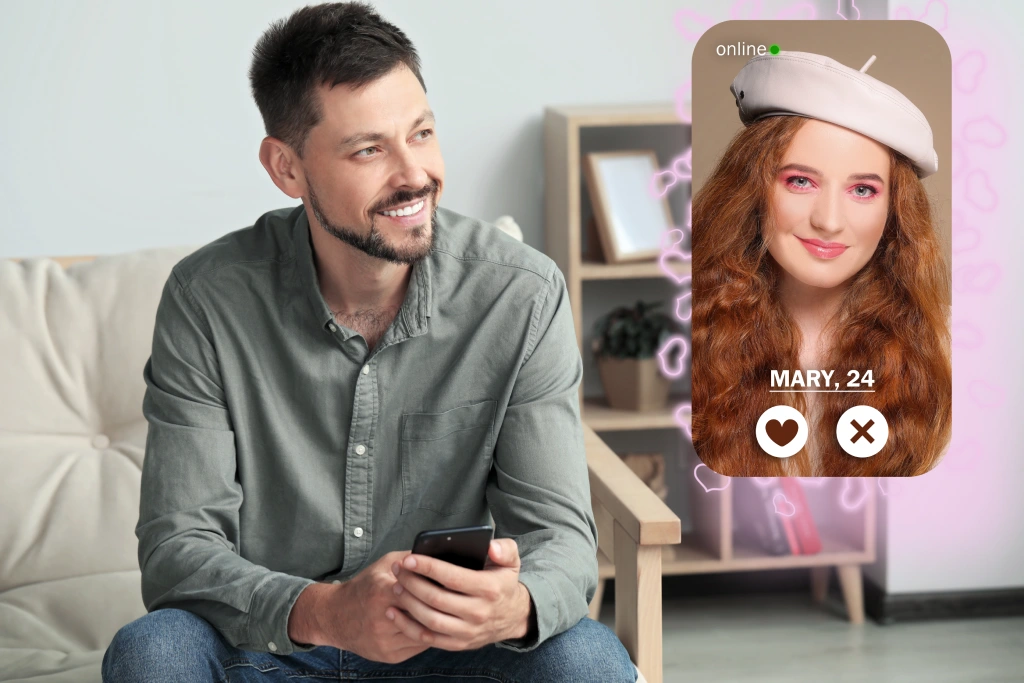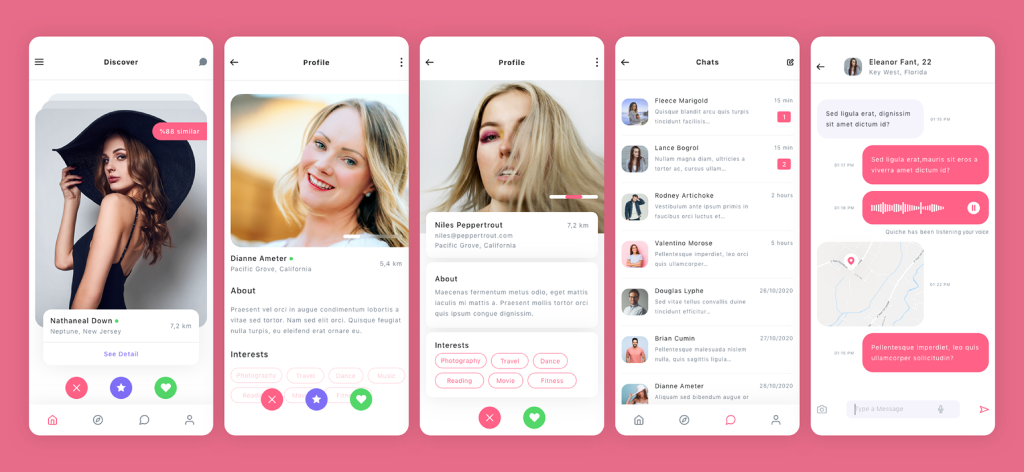Table of Contents
ToggleIn today’s digital world, is finding love just a swipe away? With platforms like OkCupid using personality quizzes and smart algorithms, dating mobile apps are becoming more meaningful than ever.
Are you thinking of building your own dating mobile app? Wondering what makes OkCupid different and how you can create something better?
This guide breaks down exactly how to build a dating mobile app like OkCupid, from features and tech stack to smart post-launch strategies. Whether you are planning the next big thing or an OkCupid alternative, let’s get started.
How Does OkCupid Work?
Before you create a dating mobile app, it’s important to understand the core model you are inspired by.
So, how does OkCupid work?
OkCupid is known for blending science, psychology, and AI to help users find matches that align with their beliefs, interests, and goals. Unlike swipe-only mobile apps, it uses personality quizzes and multi-layered filters to calculate a “match percentage” for each profile.
Key Aspects:
- Onboarding: Users register, upload photos, set preferences, and answer optional identity questions.
- Questionnaire-Based Matching: Users complete hundreds of questions ranging from politics to personal habits. This best dating mobile app analyzes responses to generate compatibility scores.
- AI Algorithms: Based on match preferences and behavior patterns, OkCupid suggests relevant users.
- Communication: Once mutual interest is shown, users can initiate messaging.
This data-first, inclusive, and user-driven approach has helped OkCupid become one of the best dating mobile apps for serious relationships, making it a strong model for your dating mobile app development journey.
Must-Have Features for a Dating Mobile App Like OkCupid
To stand out in today’s crowded dating mobile app space, your platform must offer both technical sophistication and emotional intelligence. Here are what features of a dating mobile app you need:
1. User Registration & Profile Setup
The dating mobile app must allow users to register quickly using email, phone, or social login. Use guided onboarding and progress bars to encourage full profile completion, boosting trust and match quality.
2. Matchmaking Questionnaire
You can include fun yet meaningful personality quizzes or interest-based questions. This builds user compatibility scores and creates a foundation for smart, long-term matches.
3. Smart Matchmaking Algorithm
You can use user data, like interests, location, and questionnaire responses, to generate personalized match suggestions using AI and machine learning.
Also Read: What is the goal of Artificial Intelligence?
4. Swipe or Grid Browsing
Your mobile app for dating must offer users an intuitive way to explore profiles using swipe gestures or filterable grid views. This keeps the experience familiar yet flexible.
5. Real-Time Messaging & Video Chat
Add secure in-app chat, voice, and video calls so users can connect authentically without switching platforms. Real-time interaction drives deeper engagement.
6. Location-Based Discovery
Use GPS to help users discover nearby matches while ensuring data privacy and location control. This feature is ideal for local dating and spontaneous meetups.
7. Safety & Privacy Tools
Include critical tools like profile reporting, user blocking, and ID verification. These features build trust and protect your community from spam and harassment.
8. Admin Dashboard
A powerful backend dashboard allows moderators to review flagged profiles, manage users, and analyze AI dating mobile app performance for continuous improvement.
Get a real feel of how OkCupid works, download it on the Google Play Store or App Store, and explore its core features.
Also Read: How much does it cost to build a dating mobile app like OkCupid?
Mobile App Development Process to Build a Dating Mobile App
Understanding how to build a dating mobile app requires a clear, step-by-step development process that balances user needs with technical precision. Successful dating mobile development depends on thoughtful planning, the right features, and scalable architecture.
Below are the key steps to follow to build a high-performing and engaging dating mobile app.
Step 1: Requirement Gathering
This initial phase lays the groundwork for your entire dating mobile app development project. The goal is to understand your market, define technical scope, and align business objectives.
Key areas to cover:
- Target Audience: Are you building for casual dating, serious relationships, or niche communities like LGBTQ+, single parents, or pet lovers?
- Platform Selection: Choose whether to develop for Android, iOS, or go cross-platform with frameworks like Flutter or React Native.
- Core Features: You need to list must-have features such as personality quizzes, real-time chat, video calling, and swipe-based matching.
- Monetization Strategy: Decide if your dating mobile app will use subscriptions, freemium upgrades, in-app purchases, or ads.
A clear understanding of these requirements ensures your team knows exactly how to build a dating mobile app based on your goals.
Also Read: Native vs. Hybrid Apps: Which Is Best for Your E-Commerce Business?
Step 2: Wireframing, UI Design & User Experience (UX/UI)
Once your requirements are clear, the next step is designing how users will interact with your dating mobile app, from the first screen to their first successful match. This stage blends both UI (User Interface) and UX (User Experience) to create a product that is not just functional, but emotionally engaging.
Wireframing & Prototyping: Start by developing wireframes to outline mobile app layout and flow. These low-fidelity screens act as blueprints for:
- Profile Setup: Account creation, photo upload, interests, and preferences
- Quiz Interface: Compatibility questions with clean UI and progress indicators
- Match Browsing: Swipe-based or grid-based profile views
- Chat UI: Intuitive messaging screens with multimedia support
Prototypes based on these wireframes help stakeholders visualize the mobile app early and provide actionable feedback before mobile app development begins.
Designing the User Experience (UX/UI): UX is about creating smooth journeys, while UI ensures it’s visually appealing and emotionally resonant. Below are the key UX/UI considerations as follows:
- Simple navigation: Easy to use, even for first-time mobile app users.
- Micro-interactions: Subtle animations and feedback for swipe, like, or send action.
- Accessibility: Color contrast, font readability, and assistive support for all users.
- Emotional design: Use warm colors, profile badges, and personalized content to build trust.
- Mobile-first layout: Prioritize vertical screen design, thumb-friendly zones, and intuitive gestures.
By combining smart wireframes with intentional UX design, you are not just building a dating mobile app, you are creating an experience where users feel guided, comfortable, and excited to engage.
This step directly influences retention, user satisfaction, and overall success in your dating mobile app development journey.
Also Read: How to Optimize Apps for Foldable Devices: A Developer’s Guide
Step 3: Tech Stack Selection
Selecting the right technology stack is one of the most important decisions in dating mobile app development. It ensures your mobile app is fast, scalable, secure, and capable of delivering real-time interactions, all crucial for a smooth user experience.
Here’s a breakdown of the key components you will need:
- Frontend: Use Flutter or React Native for cross-platform mobile app development with a smooth user interface.
- Backend: Go with Node.js, Django, or Laravel to handle APIs, user logic, and secure server-side operations.
- Database: Opt for MongoDB, PostgreSQL, or Firebase to manage user data, chats, and preferences efficiently.
- Authentication: Secure logins with Firebase Auth, JWT, or OAuth 2.0.
- Real-Time Chat: Implement messaging using WebSockets, Pusher, or Firebase Realtime Database.
- Location Services: Integrate Google Maps API or GeoFire for match discovery based on location.
- Voice/Video Calls: Add in-app calling with Agora, Twilio, or WebRTC.
- AI Matchmaking: Use Python with TensorFlow or scikit-learn for intelligent match suggestions.
- Push Notifications: Engage users with updates via Firebase Cloud Messaging or OneSignal.
Step 4: MVP Development
Once your tech stack and design are in place, it’s time to bring your idea to life with an MVP—Minimum Viable Product. The goal here is to launch quickly with core features, gather user feedback, and validate your concept without overinvesting in unnecessary functionalities.
Start by building only the most essential components of your dating mobile app development project:
- User Registration
- Profile Setup
- Quiz-Based Matching
- Basic Chat Functionality
Launching with this core set helps you test the mobile app in a real environment, identify usability issues, and gather insights into user behavior. Based on this data, you can plan future updates, refine features, and iterate quickly, all while minimizing risk.
An MVP also demonstrates early traction to investors or stakeholders and builds momentum as you scale toward a full-featured dating platform.
Step 5: Backend & API Integration
This stage involves building a secure and scalable backend to handle your mobile app’s core functions, like user management, matchmaking logic, chat, and profiles.
Create well-documented APIs that support smooth communication between the frontend and the backend. Use role-based access and proper authentication to protect all endpoints, ensuring data privacy and platform security, critical for any dating mobile app.
Step 6: Testing & QA
Before launch, your dating mobile app must go through rigorous Quality Assurance (QA) to ensure stability, security, and usability across devices and platforms. Perform both manual and automated testing to catch bugs and improve the user experience.
Key areas to test include:
- UI/UX consistency across different devices and screen sizes.
- Load handling to ensure the mobile app performs well under high user activity.
- Chat functionality for real-time responsiveness and message delivery.
- Security is used to protect user data and prevent breaches.
Thorough testing helps reduce post-launch issues and builds trust with early users.
Step 7: Launch & Deployment
Once testing is complete and you are confident in the mobile app’s performance, it’s time to go live.
Deploy the mobile app to the Google Play Store and Apple App Store, following each platform’s submission guidelines.
Key launch steps include:
- Preparing app store assets: app icon, screenshots, promo video, and descriptions
- Setting up ASO (App Store Optimization) to improve search visibility and downloads
- Implementing crash reporting tools and performance monitoring for real-time tracking
A well-planned launch ensures your dating mobile app reaches the right users and delivers a smooth onboarding experience.
Step 8: Post-Launch Monitoring
After going live, continuous monitoring is essential for growth and retention. Track user behavior and mobile app performance using tools like Firebase Analytics, Mixpanel, or Amplitude.
Key metrics to monitor:
- Daily Active Users (DAU) to measure engagement
- Match success rate to evaluate algorithm effectiveness
- Average session time to assess user interest
- Chat engagement to track user interaction quality
These insights help guide future updates, improve features, and ensure your dating mobile app evolves with user needs.
Also Read: How Much Does It Cost To Build A Dating Mobile App Like Badoo?
Trending Technologies to Make Your Dating Mobile App Unique
To stand out among the many OkCupid alternatives, you will need to incorporate next-gen technology. Here are a few trends redefining the space:
| Technology | Description |
| AI Matchmaking | Suggests smarter matches using behavior and preferences. |
| Voice & Video Profiles | Adds voice or video intros for more genuine connections. |
| AR Dating | Enables virtual dating experiences through Augmented Reality. |
| Blockchain Verification | Secures user identity and builds trust. |
| Behavioral Matching | Matches users based on in-app actions, not just answers. |
| Gamification | Boosts engagement with badges, streaks, and interactive elements. |
These features transform your solution from a simple swipe mobile app into an AI dating mobile app built for modern users.
Also Read: How Much Does It Cost To Build A Dating Mobile App Like PolyFinda?
Partner With Alphaklick Solution to Build a Dating Mobile App
Building a dating mobile app today requires more than just a swipe feature; it needs emotional design, smart matching, real-time tech, and security. That’s where Alphaklick Solution comes in. We don’t just code mobile apps, we build relationship-driven platforms that users trust and love to spend time on.
From intelligent match algorithms to smooth chat experiences and cross-platform deployment, we take care of everything from concept to launch. Whether you are launching a bold new idea or refining an existing concept, we have the tools, a React Native mobile app development company in India, and expertise to bring it to life.
Let’s build your dating mobile app together. Get in touch and let’s start creating something meaningful.
Frequently Asked Questions (FAQ)
Question: Is making a dating mobile app profitable?
Answer: Yes. With monetization models like freemium access, premium features (e.g., “boost” or “super like”), and subscription plans, dating mobile apps can generate significant recurring revenue.
Question: How to create a mobile app similar to Tinder?
Answer: Use swipe mechanics, location-based matches, and real-time chat as core features. Focus on mobile app speed, minimal UI, and emotional engagement.
Question: How do I create an OkCupid mobile app?
Answer: Either develop from scratch or use an OkCupid clone script. Focus on personality-based quizzes, smart filters, and clean UI. Partner with a mobile app development company in India for secure architecture and a scalable backend.
Question: Is building a dating mobile app hard?
Answer: It requires solid planning, user research, and technical execution. With the right team and tools, it’s completely achievable, even for startups with limited resources.

